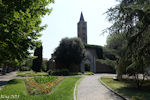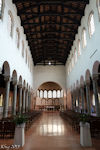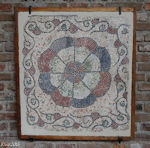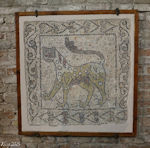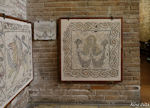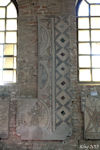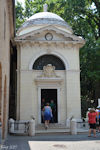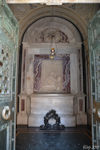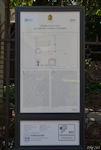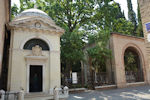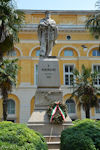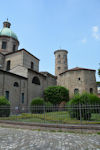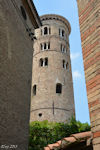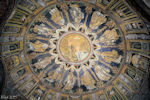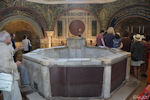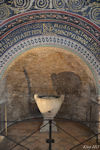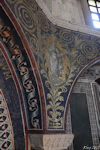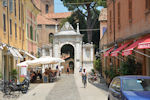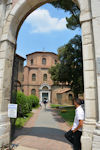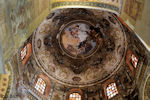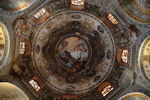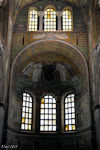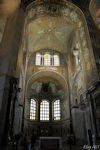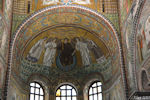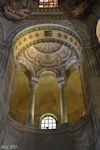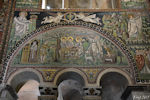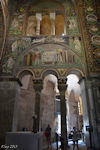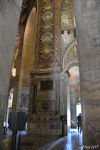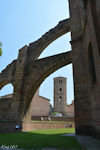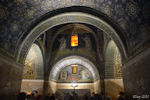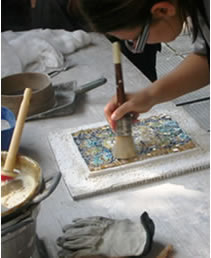
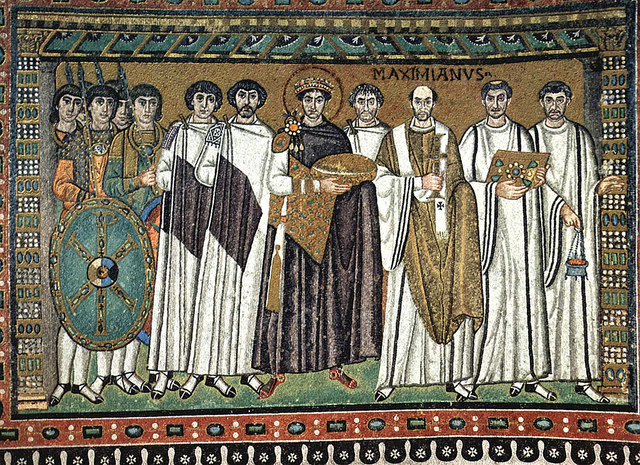
San Vitale Justinian Mosaic
Photo from pics5_thispic
Links to Port Pages
Ravenna, Italy
11 June 2015 - We arrived at the port for Ravenna early in the morning. Randy had discussed with other people on Cruise Critic about the ability to walk to town. The answer is a strong No! It's about a 20 minute drive by bus through some busy areas, along a river, and finally to town. Fortunately Silversea provides a shuttle in areas like this where it is not convenient to walk.
We had scheduled an excursion to look at mosaics and then visit a workshop to make our own. Unfortunately we were notified that the tour was cancelled for lack of attendance. So we adventured on our own and saw exquisite mosaics, Dante's tomb, old churches and enjoyed a wonderful visit. Wandering through the sites on your own and at your own speed is the best way to enjoy Ravenna. We did not miss being on a guided tour.
Here's a little more information about the sites we visited in Ravenna and some photos:
San Giovanni Evangelista - San Giovanni Evangelista is a church in Ravenna, Italy. It was built in the fifth century AD by the Roman imperial princess Galla Placidia. In the Middle Ages the Benedictines annexed to it an important monastery. In the 14th century both the church and the monastery were renovated in the Gothic style: of that intervention the portal is visible today. In 1747 the church was almost entirely stripped of its mosaics; the only remaining are two fragments of the original 5th century floor, with the first recorded Christian use of hooked crosses. Other mosaic fragments found under the bombs belong to 13th century floor and depict the Fourth Crusade and the funeral of a fox. Two of the four bells dates 1208. Heavily bombed during World War II, the building was later restored.
San Giovanni Evangelista |
Interior of San Giovanni Evangelista |
Mosaic |
Cat Mosaic |
Mermaid Mosaic |
Wall Mosaic |
Dante's Tomb - Dante (degli) Aligheri was born in Florence in (probably) 1265. Political machinations later in his life resulted in his being exiled from Florence initially for two years and then, because he did not pay the attached fine, pretty much forever. Why? Because if he returned to Florence without paying the fine he could be burned at the stake. The city of Florence only rescinded that sentence in 2008.
Exile was considered a terrible punishment and it forced Dante to live out the rest of his life elsewhere. In 1318 he was invited to live in Ravenna, where he was buried in 1321. His original tomb was in what is now Basilica San Francesco.
Florence eventually realized its mistake and petitioned Ravenna for the return of the poet's body. The tomb for the poet built inside Florence's Basilica Santa Croce in 1829 remains empty. At some point Dante's coffin was hidden (possibly when Napoleon took control) and was re-discovered in 1865, buried underneath the Braccioforte portico which is next to the existing memorial.
The small memorial building called 'Dante's Tomb' was built in 1780 in the neo-Classical style (pillars, dome etc). Above the marble sarcophagus there is a rather good marble plaque created by Pietro Lombardo in 1483 and showing the poet at work. A votive lamp hangs from the ceiling; its olive oil fuel is an annual gift from Florence.
Dante's Tomb |
Dante's Tomb |
Inside Dante's Tomb |
Information Sign for Dante's Tomb |
Dante's Tomb and park |
Piazza Garibaldi: Garibaldi Statue - Giuseppe Garibaldi (4 July 1807 – 2 June 1882) was an Italian general and politician who played a large role in the history of Italy. He is considered, with Camillo Cavour, Victor Emmanuel II and Giuseppe Mazzini, as one of Italy's "fathers of the fatherland". Garibaldi was a central figure in the Italian Risorgimento, since he personally commanded and fought in many military campaigns that led eventually to the formation of a unified Italy. He was appointed general by the provisional government of Milan in 1848, General of the Roman Republic in 1849 by the Minister of War, and led the Expedition of the Thousand on behalf and with the consent of Victor Emmanuel II. He has been called the "Hero of Two Worlds" because of his military enterprises in Brazil, Uruguay and Europe. (From Wikipedia)
Giuseppe Garibaldi Statue |
Battistero Neoniano (Battistero Degli Ortodossi) - The octagonal brick structure was erected by Bishop Ursus at the end of the 4th or beginning of the 5th century, as part of his great Basilica(destroyed in 1734). The baptistery was finished by Bishop Neon at the end of the 5th century, at which time the mosaic decorations were added. The original floor is now some 3 meters underground, so the proper structure and extent of the building can no longer be seen. The octagonal design of the building, employed in virtually all Early Christian baptisteries, symbolizes the seven days of the week plus the Day of the Resurrection and Eternal Life. The ceiling mosaic depicts John the Baptistbaptizing Jesus(depicted with beard) standing waist high in the Jordan River. To one side stands the personification of the Jordan river, with a reed in one hand and a garment in the other. A procession of the twelve apostles proceeds around the center mosaic in two directions, ending with Saint Peter meeting Saint Paul. The Baptistry is one of the eight structures in Ravenna registered as UNESCO World Heritage Sites. According to the ICOMOS evaluation of this patrimony, "this is the finest and most complete surviving example of the early Christian baptistry" which "retains the fluidity in representation of the human figure derived from Greco-Roman art".
Battistero Neoniano |
Battistero Neoniano |
Battistero Neoniano ceiling |
Battistero Neoniano font |
Battistero Neoniano small font |
Battistero Neoniano mosaics |
Basilica San Vitale - The Basilica of San Vitale is a church in Ravenna, Italy, and one of the most important examples of early Christian Byzantine art and architecture in western Europe. The building is styled an "ecclesiastical basilica" in the Roman Catholic Church, though it is not of architectural basilica form. It is one of eight Ravenna structures inscribed on the UNESCO World Heritage List.
Entrance to Basilica San Vitale |
Gate to Basilica San Vitale |
Basilica San Vitale ceiling |
Basilica San Vitale ceiling |
Basilica San Vitale above the altar |
Basilica San Vitale floor mosaics |
Basilica San Vitale full view of altar vault |
Basilica San Vitale |
Basilica San Vitale looking up at second level |
Basilica San Vitale detailed mosaics |
Basilica San Vitale mosaics on outer side of nave |
Basilica San Vitale mosaics and marble columns |
Basilica San Vitale |
Back side of Basilica San Vitale |
Mausoleo di Galla Placidia - Daughter, sister, wife and mother of emperors, Galla Placidia reigned the Western Roman Empire and halfway through the V century had this small mausoleum built. The exterior is sober in contrast with the magnificence of the interior decoration. The countless stars of the cupola make a profound impression on the imagination and sensitiity of visitors to Ravenna. The UNESCO experts describe it as "the earliest and best preserved of all mosaic monuments, and at the same time one of the most artistically perfect". The building was formerly the oratory of the Church of the Holy Cross and now contains three sarcophagi. The largest sarcophagus was thought to contain the remains of Galla Placidia (died 450), daughter of the Roman Emperor Theodosius I. Her embalmed body was reportedly deposited there in a sitting position, clothed with the imperial mantle. In 1577, however, the contents of the sarcophagus were accidentally burned. The sarcophagus to the right is attributed to Galla's son, Emperor Valentinian III, or to her brother, Emperor Honorius. The one on the left is attributed to her husband, Emperor Constantius III.
Mausoleum of Galla Placidia |
Mausoleum of Galla Placidia |
Mausoleum of Galla Placidia |
Mausoleum of Galla Placidia |
Mausoleum of Galla Placidia |
Mausoleum of Galla Placidia |
Mausoleum of Galla Placidia |
Sarcophagus of Constantius III |
After visiting the sites and strolling through town we headed back to the ship. Evening was formal and we enjoyed our dinner in the Stars Supper Club. This was a new venue for us as it is not available on the Silver Wind. We were truly thrilled with the piano bar venue, the various small bites menu, and the elegant atmosphere. You initially think you won't eat as much with the small bites, however...no issue here. We were full before the dessert course. We ate there several more times on the cruise and it became our favorite. We highly recommend it to everyone!
After evening after dinner drinks and relaxing out on the Panorama deck we headed off to our cabin. We would be arriving in Trogir, another new destination for us.
![]()
Pre-cruise Posts
"Ravenna is known as the mosaic city because of the stunning 5th-6th century mosaics that decorate the walls of its churches and monuments and because it is still one of Italy's top producers of mosaics. Ravenna has eight UNESCO World Heritage Sites, Roman sites, museums, Dante's tomb, and many cultural events. Much of the historic center is a pedestrian zone." (from http://goitaly.about.com/od/ravennaitaly/a/ravenna.htm)
A friend of Randy's recently visited Ravenna and advised us to spend the day there and not take a tour outside the area. The mosaics are world renown as mentioned in the quote above. Both of us love history and art, so this should be a perfect stop on the trip.
![]()
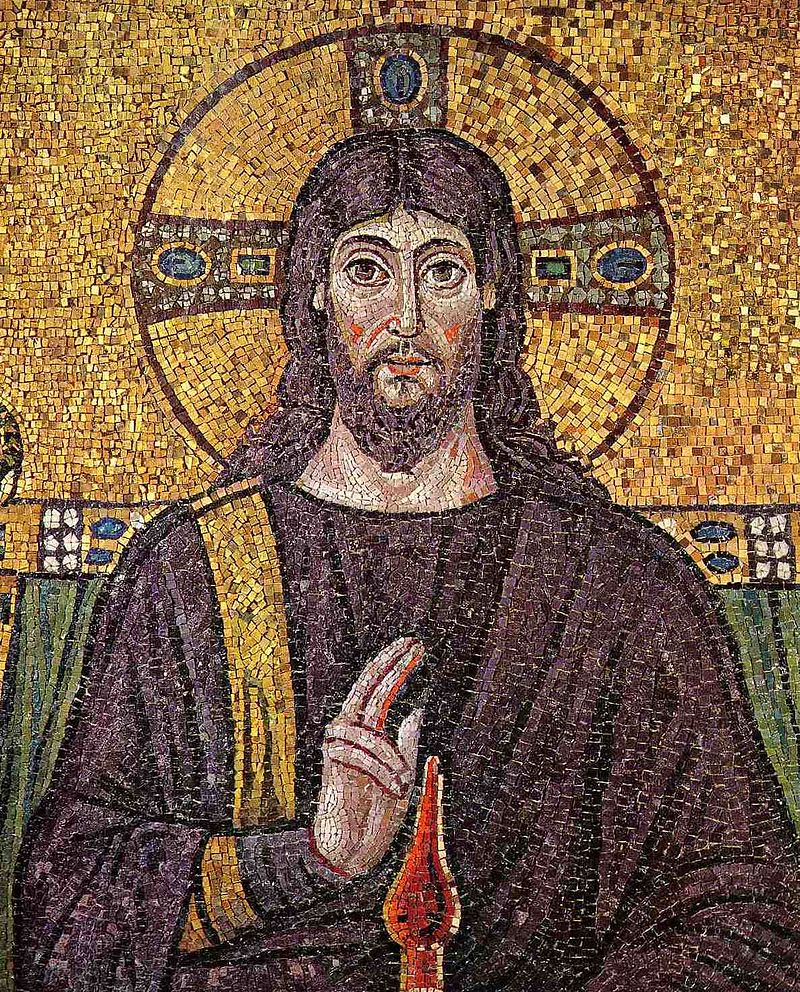 |
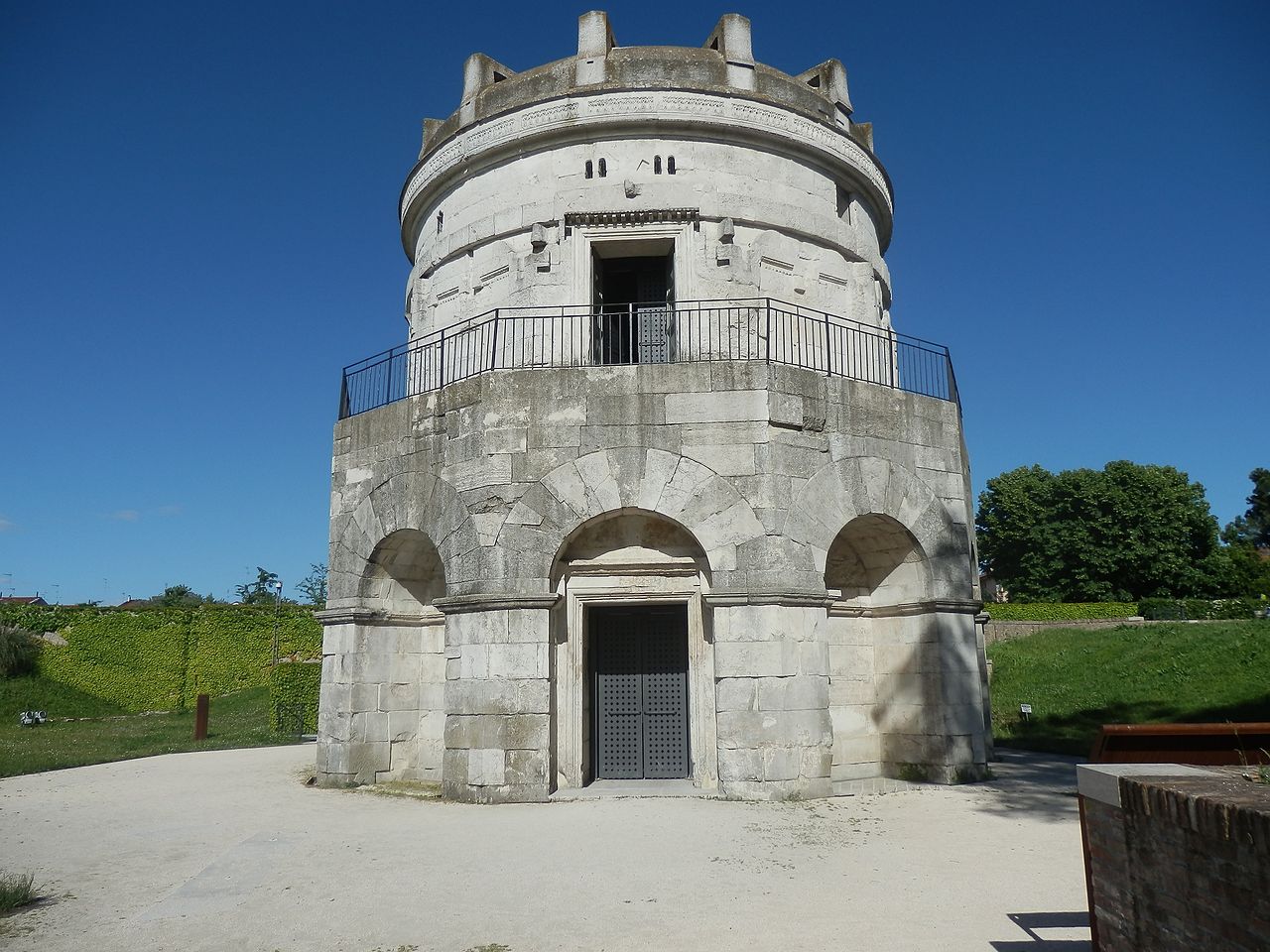 |
Christus Mosaic in Ravenna |
Mausoleum of Theodoric |
Photos from Wikipedia
![]()
What we plan to do:
We scheduled this ship excursion as it sounds like a great time - see the mosaics and make one yourself!
"Byzantine Mosaic Work Shop - Spend a half-day embracing the wonderful art of Ravenna and create your own artwork during this fun-filled, memorable mosaic workshop.
Ravenna -
Depart the pier for the brief drive into Ravenna. The former capital of the Roman Empire, Ravenna is home to some of the world's finest mosaics and eight monuments classified as UNESCO World Heritage Sites. Upon arrival, see the wonderful marble and rich, colourful Byzantine mosaics that date from the 5th century, and embody Ravenna's architectural and historical importance.
Mosaic Workshop -
Next, proceed to the Mosaic Workshop for a hands-on lesson with a renowned mosaicist. Utilising ancient and modern mosaic techniques, create your own mosaic work of art. Afterward, you may opt to re-board your coach and commence the brief drive back to the pier, or remain in Ravenna's town centre for independent exploration and shopping, and return to the ship on your own."
Photo from mosaicartsource.com |
![]()
